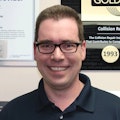Analyze your shop’s floor plan to identify ADAS opportunities, limitations
Imagine a repair that requires replacing a bumper cover, headlight and a plastic battery tray. Sounds like a cycle time miracle amid a forest filled with more complex repairs. Knowing a facility’s physical capabilities and limitations allows the proper mindset when approaching even the most seemingly simple repairs.
To achieve a safe and proper repair with increased touch time requires proper preparation. The example provided is a real. The vehicle is a 2017 Prius Prime. Approaching this repair with the mindset of simple would yield a repair devoid of OEM procedures and possibly leave some vehicle systems not functioning correctly. Today’s repairs require knowledge about all repair procedures, and the implications they have on a shop’s physical layout.
Research must be completed on every repair, regardless of severity. Researching procedures for the repair or replacement of parts will allow the proper mindset going into the repairs. For the Prius, researching each of the replacement parts and the auxiliary battery disconnect procedure yields the following additional labor items that must be completed:
- Command the active grille shutter into maintenance mode with a scan tool
- Perform ultrasonic sensor detection angle/registration (intuitive park aid)
- Millimeter wave radar sensor adjustment
- Headlight initialization (when ECU module on headlight is replaced)
- Steering angle sensor memorization
- Initialize back door lock
- Open/Close fuel door before turning ignition on after 12v disconnect (fuel gauge accuracy)
Once the research has been completed, three new pieces of knowledge have been acquired:
- What operations are necessary?
- What tools are required?
- How much space is required to perform the repairs?
Having the information about how to perform the repair is basic. Knowing before repairs commence what tools are required for initializations and calibrations is the next level. Analyzing a shop’s physical floor plan to identify opportunities and limitations in calibrations is critical to future success and a timely repair. While there are many considerations for ADAS calibrations, there are two primary physical considerations that are the largest constraints in a repair facility:
Floor space
Millimeter wave radar and blind spot monitoring systems generally require the most square footage. These systems are very sensitive and can detect at great distances on the open road. The Prius forward facing millimeter wave radar adjustment procedure requires an area in front of the car 19.7" long by 16.4" wide, with no metal objects taller than 1.97' off the ground. Add in the length of the Prius and this is a sizable piece of real estate in any facility. Also, depending on the OEM additional stall preparation may need to be performed to remove possible false targets in front of the aiming zone.
Floor slope
Most shops and dealerships were not built with ADAS in mind, so careful examination of floor conditions is required to ensure accurate results. Shop floor slope for drainage can prove problematic for ADAS calibrations. The Prius millimeter wave radar procedure requires measuring floor levelness at three points to determine if the workspace is level.
The ultrasonic sensor detection angle procedure requires a smaller footprint than both the blind spot or millimeter wave radar procedures. However, it does require eight measurement points to calculate floor slope for the front and rear of the car independently and the overall average floor slope. Then the average floor slope is checked against the tolerance in the procedure before proceeding with the calibration.
If the shop floor slope is out of specification, the car must be repositioned, and the floor measured again. Using a long digital level is probably the simplest method for measuring floor slope. Floor slope can also be calculated by using a laser level and basic trigonometry.
First, measure total vertical rise over a given length and calculate the tangent (rise divided by length). Tangent alone does not provide the angle of the floor. Taking the inverse tangent of the result will reveal the floor angle. All measurements must remain in consistent units when performing manual calculations.
The choice between calibrating in-house and sublet can boil down to the physical limitations of the shop. Having a clear understanding of the required procedures for a repair, and the implications they have on the physical space of a repair facility can aid in providing a complete, safe, and efficient repair for the customer.
About the Author
Will Latuff
Will Latuff is a manager at Latuff Brothers Auto Body, a 4th generation family run business. He graduated from UW-Stout with a B.S.in business administration and a minor in quality management. Will is an I-CAR Pro Level 3 platinum individual, who is both aluminum and steel structural welding certified. Will is an active member of AASP-MN participating on the board of directors as well as serving as AASP-MN Collision division director.
